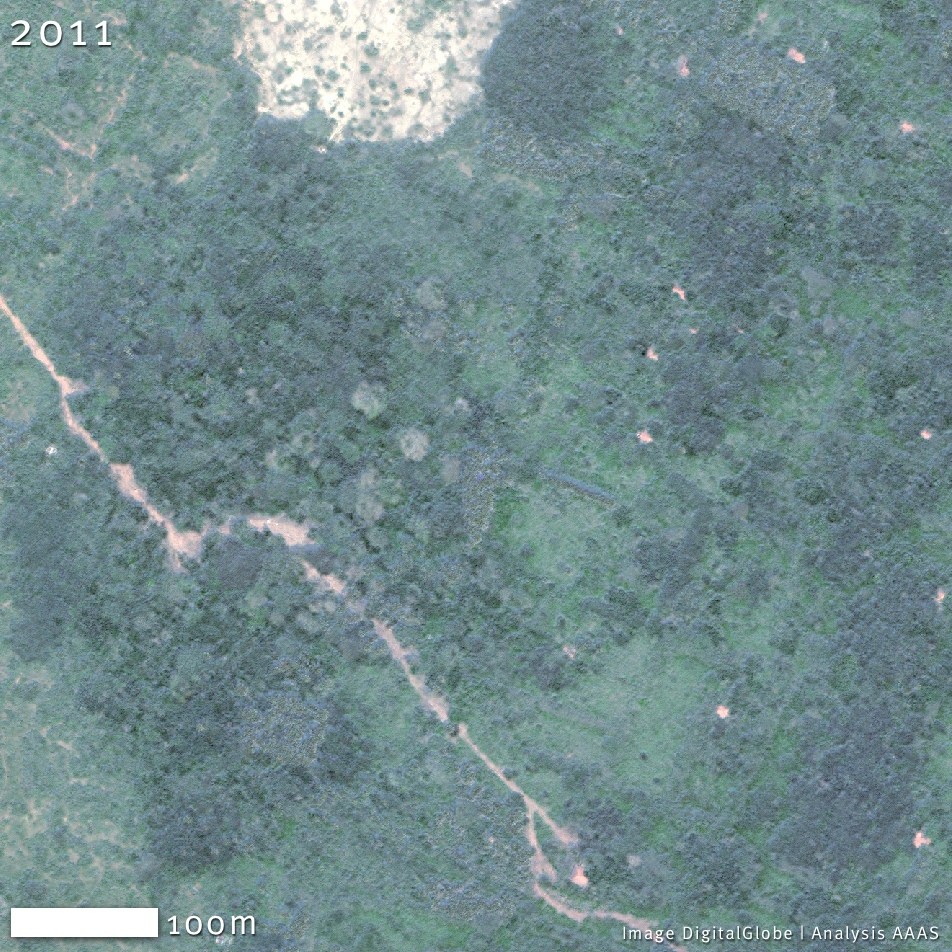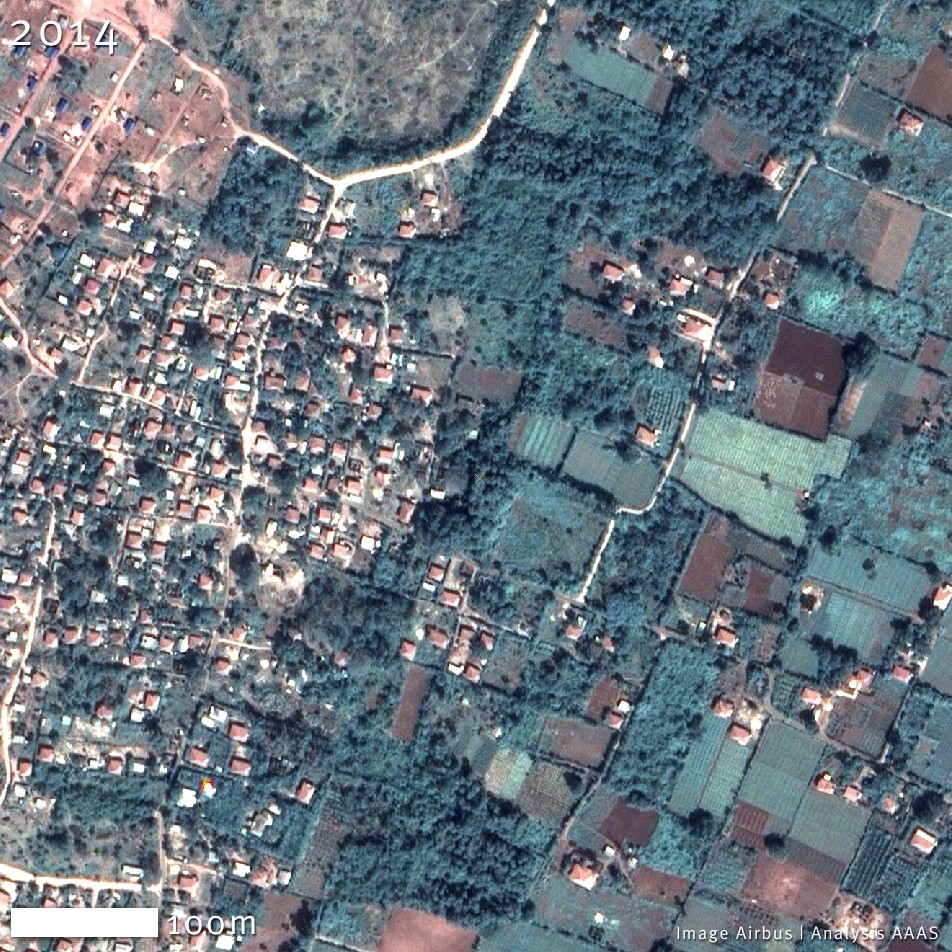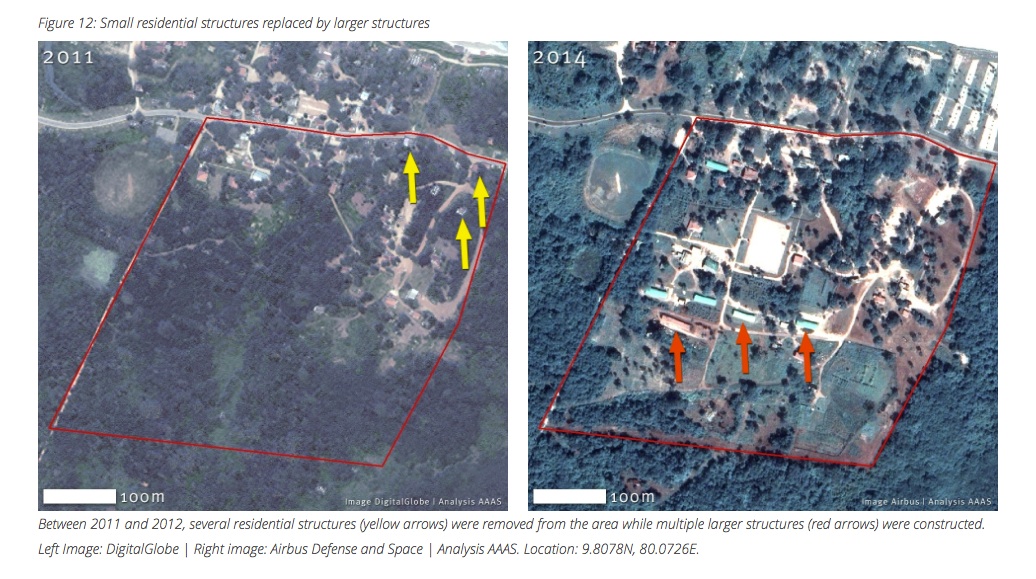by Geospatial Technologies & Human Rights Project, American Academy for the Advancement of Science, Washington, August 2014
Full report http://www.aaas.org/sites/default/files/AAAS_Sri_Lanka_2014.pdf
Between 2011 and 2014, large numbers of structures were added to the study area in a manner indicating that they were residential in nature. Left Image: DigitalGlobe | Right image: Airbus Defense and Space | Analysis AAAS. Location: 9.805N, 80.019E.


Conclusion
At the request of the Sri Lanka Campaign for Peace and Justice, the AAAS Geospatial Technologies and Human Rights Project examined the area known as the Valikamam High Security Zone over the period of 2009-2014. This HSZ, located on the northernmost point of the country, on the Jaffna Peninsula, has been under military control for several decades. AAAS investigated changes within the zone since the end of the 2009 military conflict. Specifically, AAAS aimed to assess claims by the SLC that the area was being developed outside the scope of military usage, particularly in light of assertions from former residents that they are unable to return to their former lands. AAAS observed a number of changes in the Zone during the study period relating to land use. The most obvious change was a dramatic increase in housing-style structures, particularly between 2011 and 2014 (Figure 3). This led to a lack of clarity regarding the delineation of the border between the HSZ and civilian areas (Figure 4).
To further analyze if the land was being put to public use, 18 potential institutional areas were delineated from the 2014 image. Structures in these areas were counted to assess the extent to which new structures were clustered in these areas. Though additional structures were observed in these areas, the number was minimal compared to the total number of structures added to the study area in the time period, indicating that the majority of development consisted of the construction of new residential structures.
In addition, many infrastructure changes were observed, including the creation of a large number of roads and improvements to existing roads, particularly in the form of road paving and widening. Alongside these infrastructure changes were several developments of the coastline, particularly the Thalsevana Holiday Resort and other large complexes of structures (Figures 6-8). Finally, an increased use of the land for farming was observed, but was not quantified because the images used for this analysis were from different times of the year, which precludes vegetation analysis.
For a PDF version of this case study, click here.
——————
Satellite Images Uncover Lies Spewed By SL Military In Jaffna Land Grabs
by ‘Colombo Telegraph,’ August 21, 2014
Exposing blatant lies spewed to Northern civilians by the military under the blessings of the Rajapaksa-regime in order to support the rampant land grabbing racket following the end of the war, a close analysis of satellite images have disclosed that over 50% of the land acquired by the Army through such means is not being used for its stated purpose.
 The analysis that had been carried out by the Geospatial Technologies and Human Rights Project of the American Association for the Advancement of Science (AAAS) upon a request made by Sri Lanka Campaign for Peace and Justice, has revealed the majority of the 25 sqkm stretch of land in the Jaffna Peninsula that is presently declared out of bounds to anyone except the Army and those they permit to enter, has not been deployed for its stated ‘public purposes’.
The analysis that had been carried out by the Geospatial Technologies and Human Rights Project of the American Association for the Advancement of Science (AAAS) upon a request made by Sri Lanka Campaign for Peace and Justice, has revealed the majority of the 25 sqkm stretch of land in the Jaffna Peninsula that is presently declared out of bounds to anyone except the Army and those they permit to enter, has not been deployed for its stated ‘public purposes’.
The land that had accommodated close to 2000 Tamil families before the conflict was abandoned during the war. However, following the end of the war, its original owners have sought legal assistance to reacquire the lands that have been encroached upon by the military, but to no avail.
The careful analysis of the satellite images have revealed that:
- Only 7.77 sqkm of the land (amounting to only 30% of the total land strip acquired by the military) have been used for any purpose
- Majority of the land has been used for farming, widely carried out by the military that has by way stifling local farmers
- Although nearly 2,150 houses have been constructed in the western half of the zone they do not appear to be part of any military base
- Emergence of commercial developments within the zone including the Thalsevana holiday resort
- Deterioration of many of the original houses due to lack of repairs
Commenting on the facts that have been exposed, Campaign Director for the Sri Lanka Campaign for Peace and Justice, Fred Carver had stated that the satellite image analysis has revealed that the military deprived close to 2000 people of the right to their original lands to line the pockets of the Sri Lanka Army.
“More seriously it suggests that the Sri Lankan Army is still keen to ensure that it’s military are a visible and active presence within the day to day life of Sri Lanka’s northern Tamils – a form of state oppression which, combined with systemic human rights abuses, we have previously deemed an ongoing crime against humanity,” he has added.
Read the full report and images here
[…] Monitoring Change in Sri Lanka’s Valikamam High Security Zone: […]